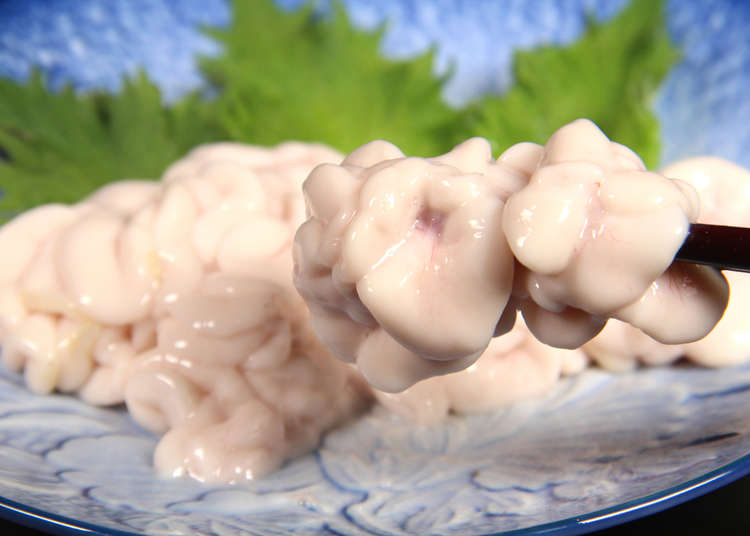
18 Strange Japanese Foods That Are Actually Pretty Good!
- Written by: Sohail Oz Ali
When traveling, the first thing people usually notice is how different or similar the food is to their own country. And if you don’t come from Asia or are not familiar with Asian food, than you might be surprised to see many things that are eaten in this part of the world.
When I first came to Japan around 10 years ago, I thought the strangest and most unique food Japan had to offer was raw fish in the form of sushi and sashimi. However, after living here for many years, travelling to many parts of Japan, eating at a variety of Japanese restaurants and being introduced to many kinds of dishes, I have to say sushi is looking pretty normal.
Here are some foods that may appear strange to foreigners but are quite delicious and findable in Japan.
1. Fermented Soybeans - Natto
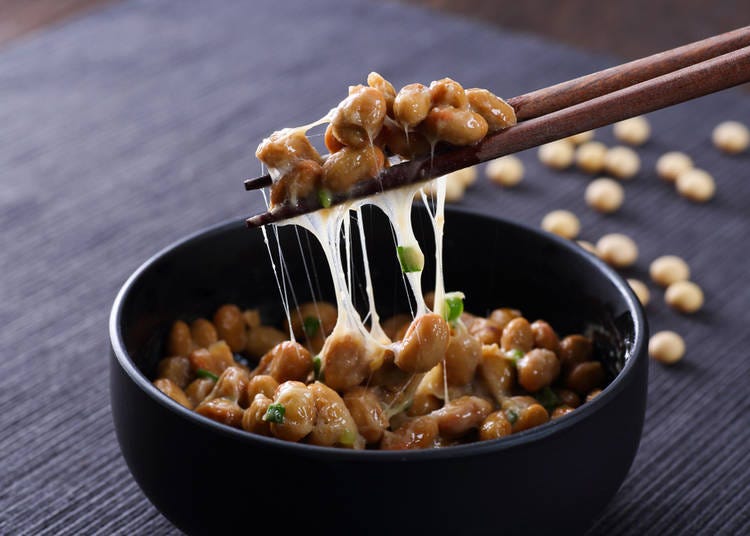
Anyone who has been to Japan or talked to Japanese people will know that natto is a popular food all Japanese people have grown up with and is usually part of a Japanese breakfast. Natto is fermented soy beans and is a gooey, sticky, slimy, smelly mess of a food that all Japanese people tout as the healthiest of Japanese foods.
The soybeans are steamed, fermented and then refrigerated for about a week. You can usually buy a three pack of natto for less than 100 yen so it is cheap and easy to prepare.
Adding some soy sauce and Japanese mustard, the mixture is mixed vigorously until it is sticky and gooey. The easiest way to eat natto is plain or on top of rice. But there are a variety of foods that can be eaten with natto like raw eggs, okra, salads, toast, and kimchi for those who like a little spice.
I will admit that I am not the biggest fan of this food, but I have slowly gotten used to it and can now appreciate its taste and texture. It’s still not my go-to food though. If you can eat and even enjoy natto then it will please and shock a lot of Japanese who often assume only Japanese who are used to it can stomach it.
2. Raw Horse - Basashi
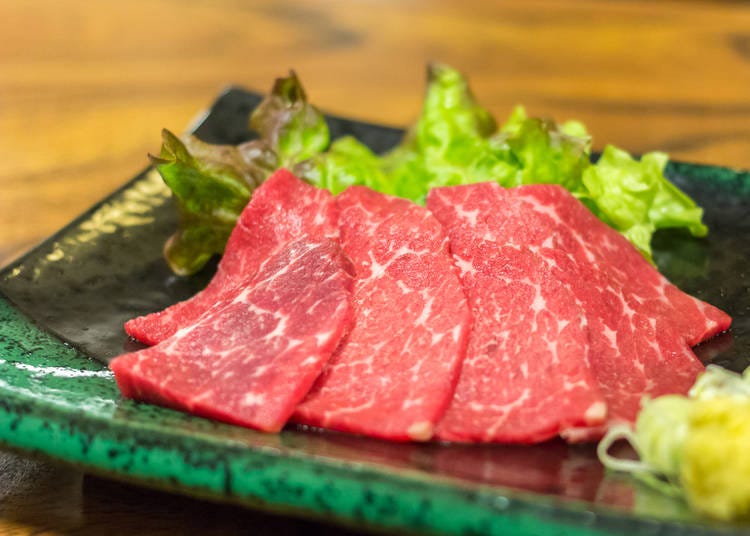
I’ve heard the term “I’m so hungry I could eat a horse” but I never thought people actually did. And not only is raw horse eaten in Kumamoto, the south of Japan where it is quite famous, but all across Japan you can find restaurants serving it.
Like fish sashimi, horse sashimi called basashi is available at many izakaya and yaki-niku restaurants. Similar to fish sashimi, it is dipped in soy sauce and eaten raw or sometimes grilled over a flame like beef in yakiniku restaurants.
It looks very similar to raw cuts of beef so I was a bit hesitant to try it but after eating a few strips I was impressed. The meat usually comes with garlic or grated ginger on top and is not chewy but tender and doesn’t have any gamey aftertaste like goat or lamb meat.
3. Bitter Gourd - Goya
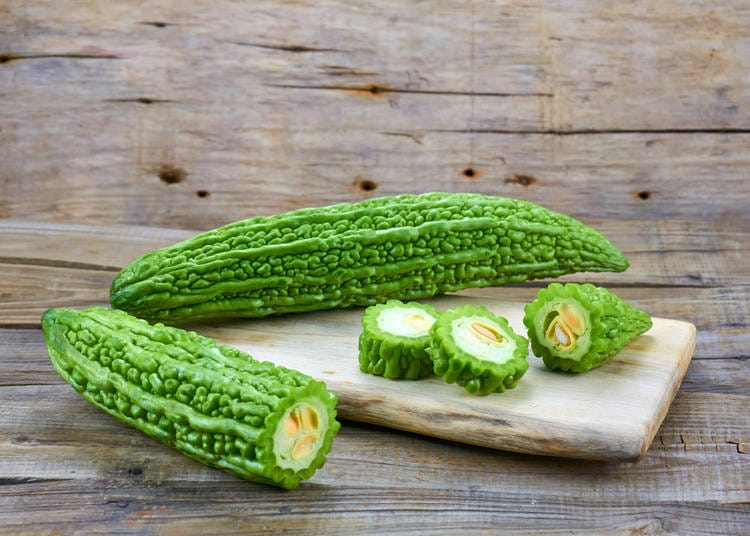
Goya or bitter gourd is a zucchini-like shaped vegetable from Okinawa that has a bitter taste and is popularly used in the famous Okinawan dish called Goya Champuru.
When I went to Okinawa and ordered the Goya Champuru dish, which is egg, tofu, soy sauce, meat and vegetables stir-fried, the combination was great and the goya only had a slight bitter aftertaste which made the dish taste even better and more unique. Goya can be added to salads, made into a smoothie or even eaten tempura style. The benefits of this food goes beyond the taste.
Goya is said to be a superfood and according to the US National Library of Medicine, goya has been used around the world traditionally for many medicinal purposes to help with digestion, lowering blood sugar for those suffering from diabetes, and is in the clinical stages for its ability to fight cancer cells.
Okinawa is known globally to have one of the longest life-expectancies and houses the highest number of citizens over 100 years old. Could Goya and other Okinawan foods be one of the reasons Okinawans live such long lives?
4. Raw Chicken - Torisashi

It would be unheard of in North America for anyone to eat raw chicken, let alone have a restaurant serve it on purpose. Lawsuits and health risks with eating raw chicken make it hard to believe that in Japan not only can you find raw chicken sashimi in restaurants but many people eat it and it’s delicious.
With the question of “Which came first, the chicken or the egg?” in this situation it doesn’t matter because Japanese people will eat both of them raw. In other countries where eating raw foods may seem strange, here in Japan the art of cooking, or not cooking things has made dishes using raw meat popular.
Raw chicken is taken from the inner part of the chicken’s breast which has the least chance of contamination and is slightly cooked for less than ten seconds. Much like fish sashimi, it is dipped in soy sauce and eaten raw. I had a chance to try it at a local izakaya in my town and it tasted great. It wasn’t chewy or rubbery like I was expecting but had a similar texture to tuna sashimi. It also tasted similar tuna sashimi as well.
Having tried it once is enough for me though, as I can say I ate chicken raw and lived to tell about it. It was definitely a food that sounded scary but turned out quite normal.
5. Pollock Roe - Tarako & Mentaiko
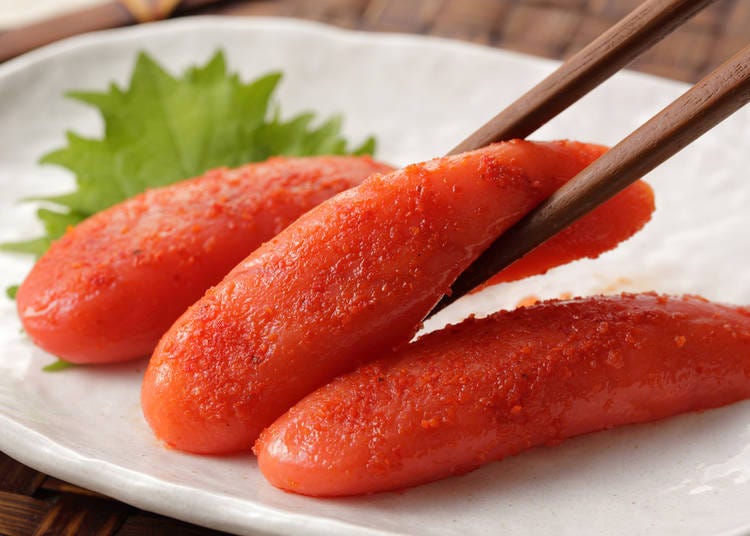
These sausage looking things are actually a sac of cod roe that have been salted and in the mentaiko version, spices are added. A thin skin membrane keeps all the cod roe eggs together and when eaten raw has a very salty taste.
When cooked, the tarako actually becomes more sausage textured. It is often eaten as a side dish or put into rice balls. The plain tarako is a light pink color but when spices are added to make mentaiko, it usually looks a lot more red.
Mentaiko is popular as a topping for pasta in many restaurants as well. Because of the salty-spicy taste, mentaiko is also a good dish accompanied with sake or shochu alcohol. Recently you can find many mentaiko flavored dishes in Japan from mentaiko chicken nuggets and butter spread to mentaiko flavored potato chips and mentaiko mayonnaise.
6. Fish Sperm - Shirako
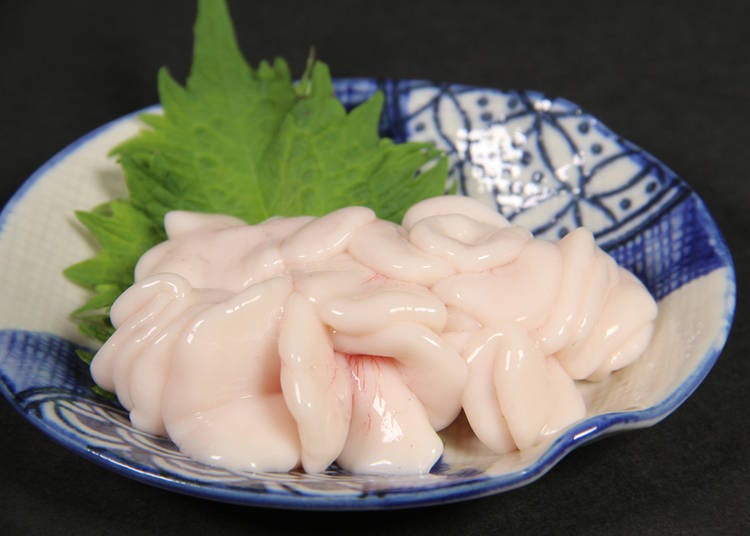
I know this sounds scary and a little disgusting in English, but many Japanese people love Shirako and it’s a quite expensive delicacy. Shirako are the sperm sacs of various sea-dwelling creatures, and it is served raw on sushi, rice, as tempura and is also popularly used in hot pot dishes. The buttery, creamy texture and slight sea-like after taste is widely loved and sought after by the Japanese.
I tried this by accident at a work party. It looked like some kind of internal organs of a fish but everyone said it is really delicious and rich tasting and I should at least try it once. After I took a bite and found that it was quite buttery and smooth, I replied with a thumbs up. Only later did I learn what I ate was fish semen or milt, otherwise known as shirako.
Now, even after knowing what it is, if it is offered to me at a restaurant or gathering I always eat and enjoy it.
7. Whale Meat - Kujira
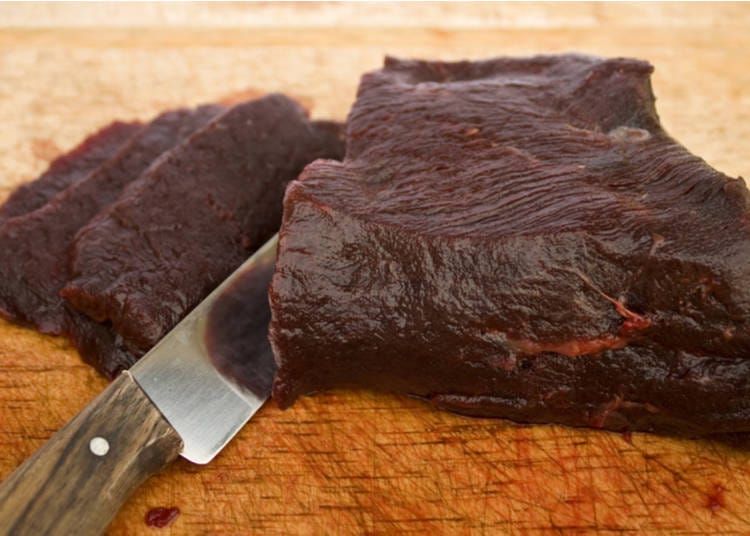
A controversial food, whale meat was a big part of the Japanese diet post-war as traditional meat like beef and pork was expensive and in low supply. Many school lunches and homes used whale meat as it is high in protein instead. However, more recently, whale meat is no longer eaten widely but rather tends to be available in specialty shops.
You will most likely come across a restaurant or a shop that sells or serves whale in more traditional parts of Japan and in areas of Tokyo like Ueno and Asakusa.
I tried whale jerky from a shop in Ueno. It was chewy but had a great salty-fishy flavor I quite enjoyed. It went great with a cold Japanese beer. I also was introduced to whale sashimi and boiled whale dishes at an izakaya with some Japanese colleagues. The meat was thicker than regular fish meat and a bit more chewier with a salty fish taste. But the slightly grilled version was really good and melted in my mouth. You likely won’t be eating this dish much in Japan but it is definitely worth a try.
8. Intestines - Horumon
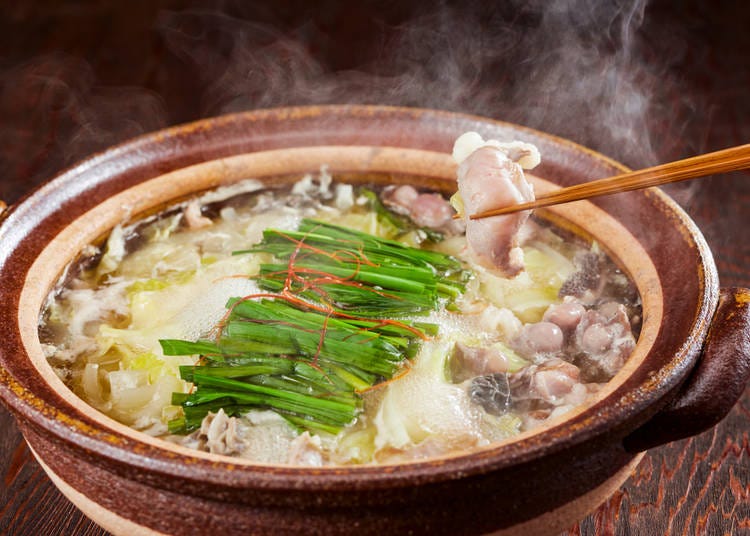
It might take guts to eat this food which is perfect because this is literally cow and pig guts. Horumon is derived from the Japanese Kansai dialect horu-mono which means things that are thrown away. Which makes sense because most people remove all the internal organs and discard them rather than consuming them. However, horumon is quite a popular and loved food in Japan.
It is eaten mostly in two popular styles. One method, which was popularized in Osaka, is to grill it along with other meat at yakiniku restaurants. Horumon has a very different shape and texture than other parts of meat and is quite chewy and tubular. The taste is also a bit sweet compared to other cuts of meat.
The second most popular method, which comes from Kyushu, is to eat it in a hot pot dish called Motsunabe. A hot, salty boiling pot with garlic, leek, other vegetables and meat along with intestines. The dish is quite inexpensive and has lots of collagen which is good for health and skin.
9. Chicken Cartilage - Nankotsu
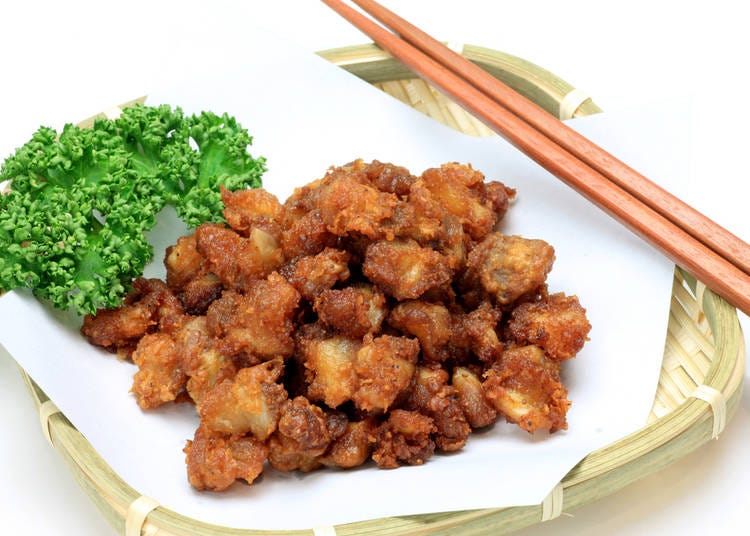
A popular dish served at many izakayas, I first popped one of these deep fried breaded chicken cartilage balls in my mouth expecting it to be popcorn chicken. Nankotsu is hard and crunchy bone cartilage so I almost spat it out thinking someone had mistakenly deep fried bones rather than chicken meat.
However, I then learned that this was done on purpose and that topped with some lemon juice, this greasy, gritty plate of bones is actually a delicious bar food. Nankotsu can also be served on a skewer in a yakitori style but I much prefer the breaded and deep fried version as the grease and crunch add to the experience.
10. Sea Grapes - Umi Budo

Another Okinawan specialty, sea grapes or umi budo are not actually grapes but a form of seaweed found in the south of Japan. They resemble tiny grapes and are salty juicy bubbles that have a refreshing and delicious flavor that burst in your mouth.
Eaten raw and dipped in soy sauce, you will find umi budo as a side dish in a lot of Okinawan restaurants and izakayas. They are a cheap, healthy and delicious dish that are perfect for vegetarians, those looking for healthy izakaya food alternatives and those hoping to try traditional Okinawan delicacies.
11. Puffer Fish - Fugu
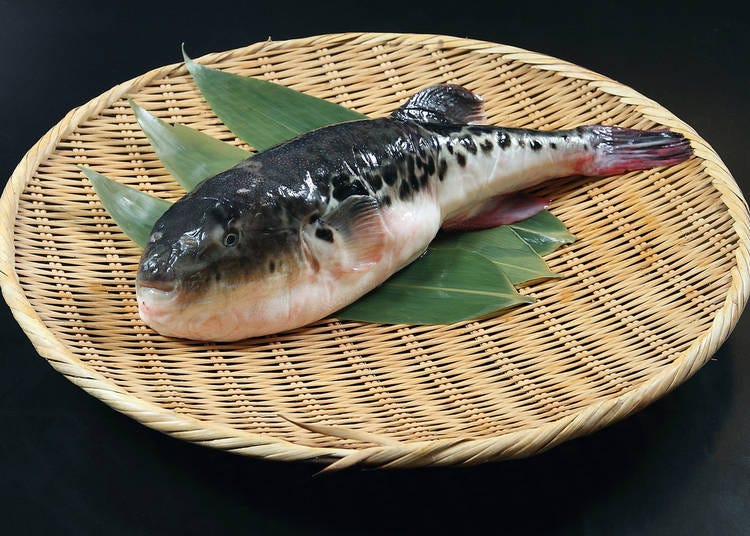
The dreaded puffer fish or fugu fish known to contain poisonous toxin that can lead to paralyzation and even death, is one of the most expensive and dignified dishes in Japan.
I first heard of this fish on The Simpsons cartoon when Homer consumed it and was told he was going to die. This stayed with me as I came to Japan and on multiple occasions was offered fugu but refused.
I feared I would be a victim despite the strict regulations placed on the serving of fugu and the fact that according to the Tokyo Bureau of Social Welfare and Public Health, there are less than 6 deaths per year from eating fugu. And most of them were from eating fugu that was caught and eaten privately rather than at a restaurant. The chefs who cut and serve the fugu also must earn a license and do a 3 year apprenticeship to be allowed to serve fugu to customers.
Then, at the end of year work party, we were served a nice hot pot stew with amazingly delicious fish meat that I thought was chicken. It didn’t have any bones and had a chicken like texture so I had two bowls of it before being told I was eating fugu. I panicked and my mind made me think I was going paralyzed but I was fine. In fact, my fake brush with death made me remember the experience even more vividly and I have tried fugu (knowingly) many times after that.
12. Sea Urchin - Uni
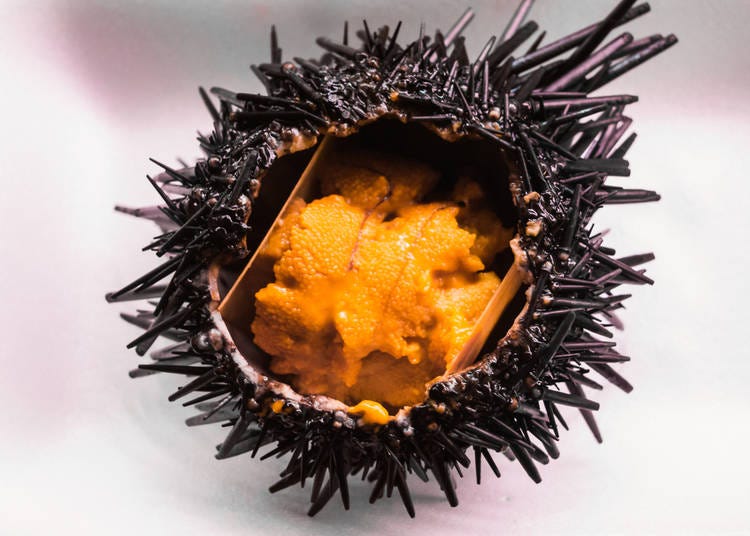
A round barnacle looking sea creature with large, sharp spines, they are often called sea hedgehogs. The edible parts of the sea urchin are the creature's reproductive organs and are quite an expensive and savory food.
Japanese people eat uni raw as sashimi and sushi. It is also popularly served on toast or pasta and has a very thick and creamy feel to it. It has a strong sea taste but has a texture like cream cheese and is quite rich so is only eaten in small portions.
Uni is quite popular and expensive in Japan and according to a report from the Urchin Project, 50,000 tons of uni is consumed in Japan which makes up 80% of all worldwide consumption.
So Japanese definitely love their uni and having tried it many times myself, it is definitely an acquired taste.
13. Baby Whitebait Fish - Shirasu
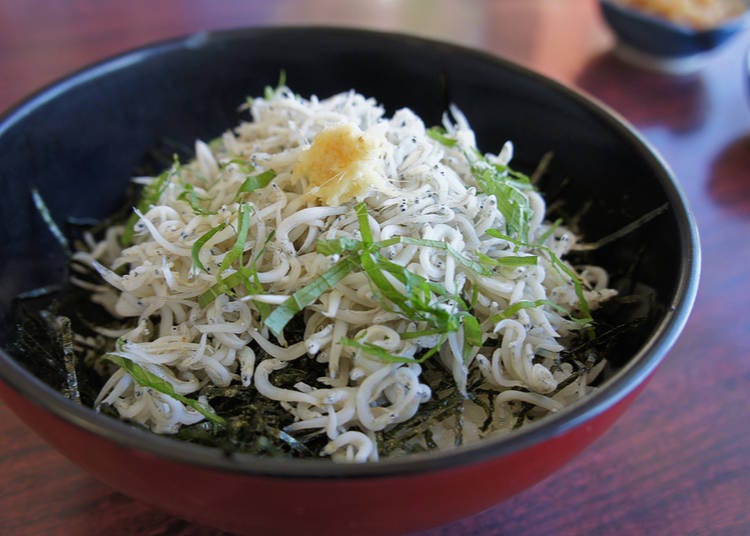
If the fact that Japanese love and are willing to eat fish sperm (shirako) surprised you, perhaps this will too. Shirasu or whitebait are tiny, immature fish that travel in schools and are soft and tender meaning they can be fully consumed without removing bones, fins or guts.
Shirasu are eaten as a topping on rice called shirasu don, in salads, in ice cream, on ramen, as a topping on pizza or just on their own. I find the taste is a very light fish flavor and more than flavor, the texture it brings to any dish makes it an easy to eat food choice. Once you get past the fact that you are eating an entire school of baby fish in one mouthful, you will enjoy the subtle taste of shirasu.
14. Cow Tongue - Gyutan

I never thought I would be tasting a food that tastes me back, but cow tongue or gyutan is one of my favorite foods to eat in Japan. It is my go-to when heading to a yakiniku grilled meat restaurant. Thinly sliced cow tongue, lightly grilled and dipped in lemon juice is the perfect combination with a bowl of rice.
Most popular in Japan's northern city of Sendai, gyutan has gained nationwide popularity and is part of every yakiniku restaurant’s top choice meat. Beyond eating in the traditional grilled fashion, gyutan is also popular with ramen, curry and stew.
15. Locusts - Inago
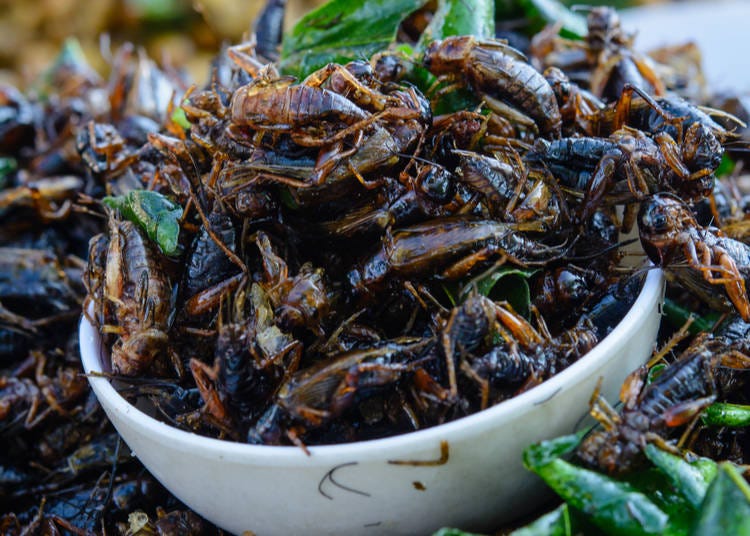
Insects are a food in many parts of Asia like China, Thailand and Indonesia but are not quite as prominent in Japan. But one insect, the locust, was traditionally eaten in areas of Japan like Nagano and Fukushima during times of plague when all the crops were destroyed by locusts. Needing food, people turned to these locusts, which are high in protein as a food source.
Inago is not widely eaten or available but some izakayas and smaller shops and restaurants in the Japanese countryside still prepare, sell and consume them. Locusts are caught and kept in a box or bag for a day to remove all feces. Then they are boiled in soy sauce and sugar. To drain the water they are fried in a pan and then deep fried in oil to make them crispy.
The hardest part about eating Inago is the appearance. Because the locusts maintain their original shape as when they were alive, the mind has to wrap around the idea of biting into a bug. But once you take a bite and taste the crispy sweet goodness that reminds me of grilled shrimp, it is hard to stop. From cautiously putting one in my mouth and biting down on the crunchy carcass to finishing off an entire bowl with a bottle of beer, the experience was unique and immense.
16. Octopus Balls - Takoyaki
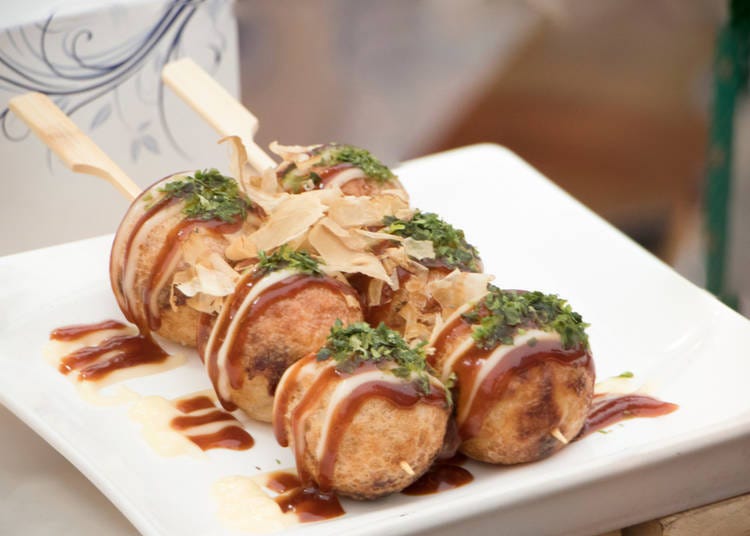
Many foreigners have heard the translation of takoyaki and thought they were being offered octopus testicles. However, balls are just the shape of the food, with the actual octopus meat being placed inside the ball of dough.
Takoyaki, a food that originated in Osaka is one of the most popular festival street foods in Japan. Bits of chopped up octopus, green onion and ginger are mixed in a wheat batter and placed in a special waffle iron type hot plate to create the shape of balls. These balls are then placed on a tray and topped with mayonnaise and/or takoyaki sauce which is a sweet and savoury sauce made of sugar, ketchup and worcestershire sauce.
It is quite easy to make and many Japanese people have mini takoyaki hot plates at home they use to have takoyaki home parties.
I especially love takoyaki when it is topped with mentaiko mayonnaise and fish flakes. Just be careful not to pop the whole ball in your mouth as it is extremely hot on the inside and you might burn your mouth as all the hot octopus goodness explodes.
17. Curry Bread - Kare Pan
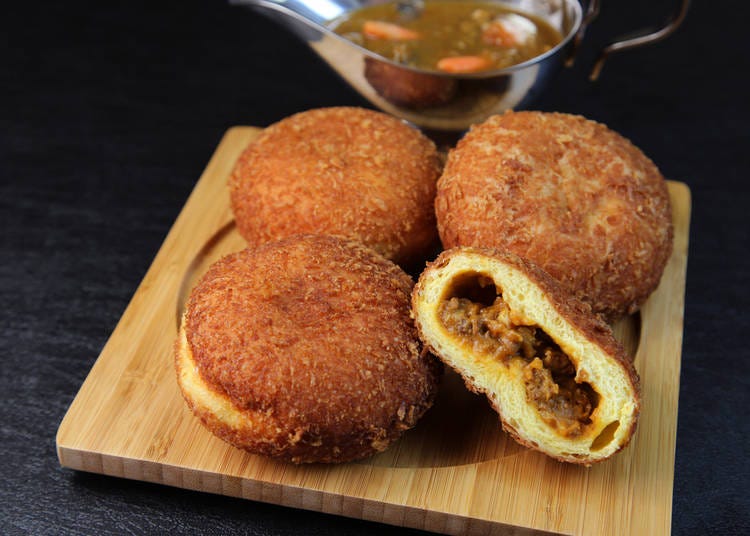
Although curry bread are deep fried dough and resemble donuts that you would find at a bakery or donut shop, they are not sweet. Dough filled with curry, then covered in breadcrumbs are deep fried in oil giving the appearance of a stuffed donut. The outer dough is very greasy and bun like making it a filling and convenient way to eat curry on the go.
Curry bread is found in bakeries alongside sweet breads and croissants as they are a popular breakfast food but they are a savoury rather than sweet cuisine. I often eat curry bread when I am in a rush and don’t have time to eat breakfast or as a snack to satisfy my hunger between meals. Curry breads also come in different types of curry filling like beef, keema curry and sausage curry.
18. Monjayaki
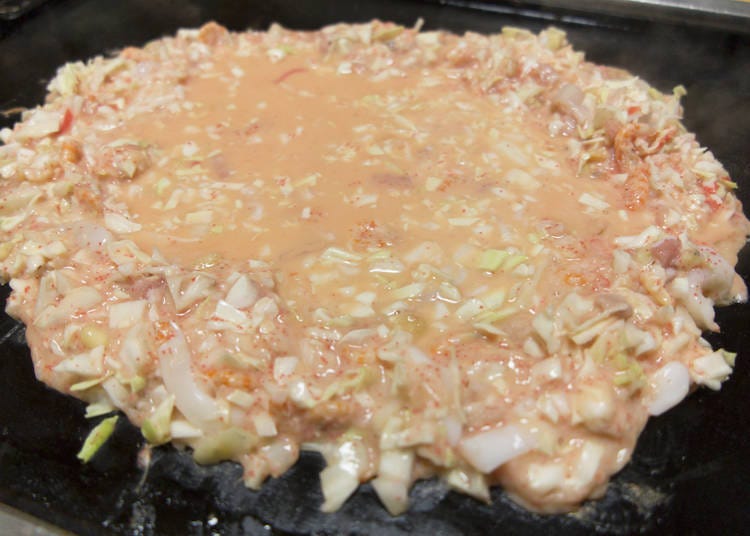
There is no English word for this food but a good description would be runny batter. I am not going to lie but it looks like vomit on a grill. But despite that terrible description, monjayaki is probably in my top five foods in Japan.
Popular in the Kanto region, monjayaki is a pan fried batter similar to Okonomiyaki but uses a lot more water making it runny looking. All the ingredients are served in a bowl. Diners place all the ingredients on the flat table grill provided and using metal spatulas, chop up all the ingredients and add the liquid mixture and water to the grill. The scrambled mess slowly starts hardening on the grill. A small spatula is then used to scrape bits of the batter and eat them directly from the grill.
It all sounds so strange and messy but the taste is quite amazing. The bottom part is crispy and has a nice barbecue taste while the top of the batter is still soft and runny. The combination in your mouth is amazing and with so many variations of monjayaki, it never gets old. Some of my favorite monjayaki ingredients are cheese, seafood, pork, mentaiko and curry. Definitely an iconic Tokyo food that not many foreigners have tried but should not be overlooked.
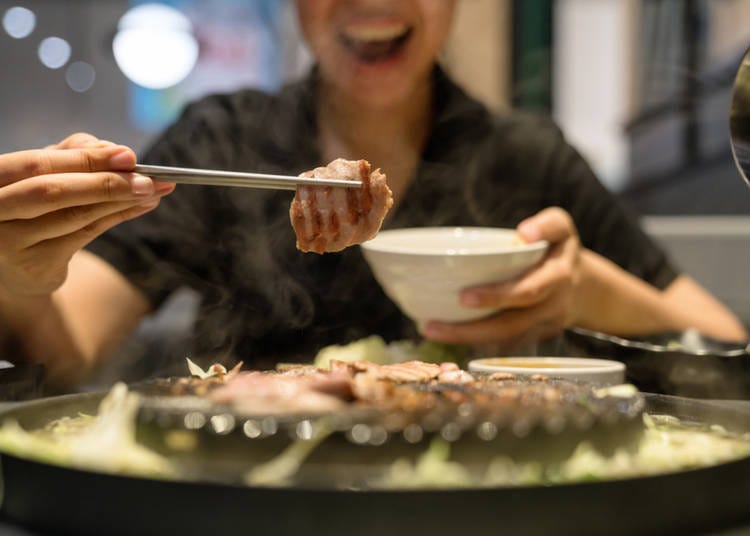
The moral of this story is not to judge a book by its cover. Some of the foods in this article may not look appetizing or might even sound inedible but the reason why Japanese food is so unique and delicious is the various amounts of ingredients and cooking styles, the Japanese are willing to try and invent.
The best part of traveling is to get out of your comfort zone and try something new and adventurous. That is no different when it comes to food. Trying and experiencing different cuisines from Japan will bring you one step closer to understanding and appreciating the culture and food of Japan.
Sohail Oz Ali is a Canadian Youtuber, author and blogger who has lived in Hokkaido, Nagoya and now resides in Chiba. Between visits to Karaoke and revolving sushi restaurants, he enjoys walking his dog, watching Japanese love dramas and teaching English. You can also find him roaming the streets of Japan looking for the next big YouTube video trends.
- Category
*Prices and options mentioned are subject to change.
*Unless stated otherwise, all prices include tax.
Popular Tours & Activitiess
Recommended places for you
-
Ad

(Opening in Jan 2026) 'THE SUMO LIVE RESTAURANT HIRAKUZA GINZA TOKYO!' 5 Exciting Ways to Experience the World of Sumo!
-

This Winter, Godzilla Takes Over Haneda Airport
by: Guest Contributor
-

Strawberries, Style, and Tokyo’s Coolest Neighborhood: Winter Afternoon Tea in Kichijoji
by: Guest Contributor
-

Jujutsu Kaisen Takes Over JR East With a Wrapped Shinkansen This Winter
by: Guest Contributor
-

First Japan Cherry Blossom 2026 Forecast Announced! Here's When & Where to See Sakura in Japan
-

Japan’s Shinkansen Is About to Change Travel in an Unexpected Way
by: Guest Contributor
-

Visiting Japan's Miffy Cafe Will Make Your Heart Melt (Photos)
-

Aizu-Wakamatsu Sake Crawl: Enjoy the Heart of Fukushima's Sake Culture
-

What are Meibutsu? The Incredible World of Japanese Regional Dishes (Not Just Sushi!)
-

Oga Aquarium GAO Guide: Fish, Polar Bears and...Godzilla?
-

Top 10 Japanese Rice Crackers & Snacks by Kameda Seika - Japan’s Leading Rice Snack Maker!
-

What to Eat in Kobe: 7 Local Foods You Can't Miss
- #best sushi japan
- #what to do in odaiba
- #what to bring to japan
- #new years in tokyo
- #best ramen japan
- #what to buy in ameyoko
- #japanese nail trends
- #things to do japan
- #onsen tattoo friendly tokyo
- #daiso
- #best coffee japan
- #best japanese soft drinks
- #best yakiniku japan
- #japanese fashion culture
- #japanese convenience store snacks



















